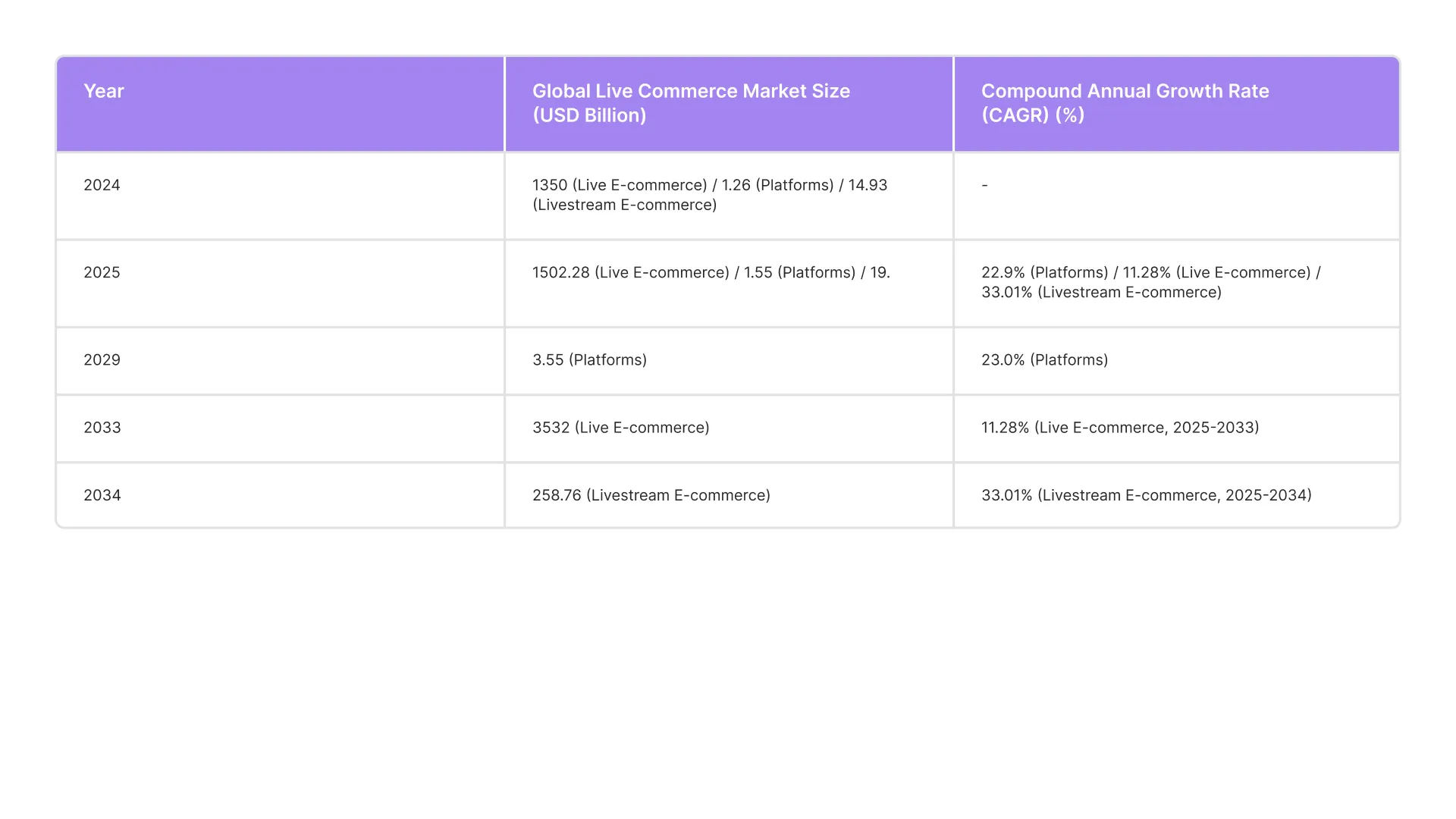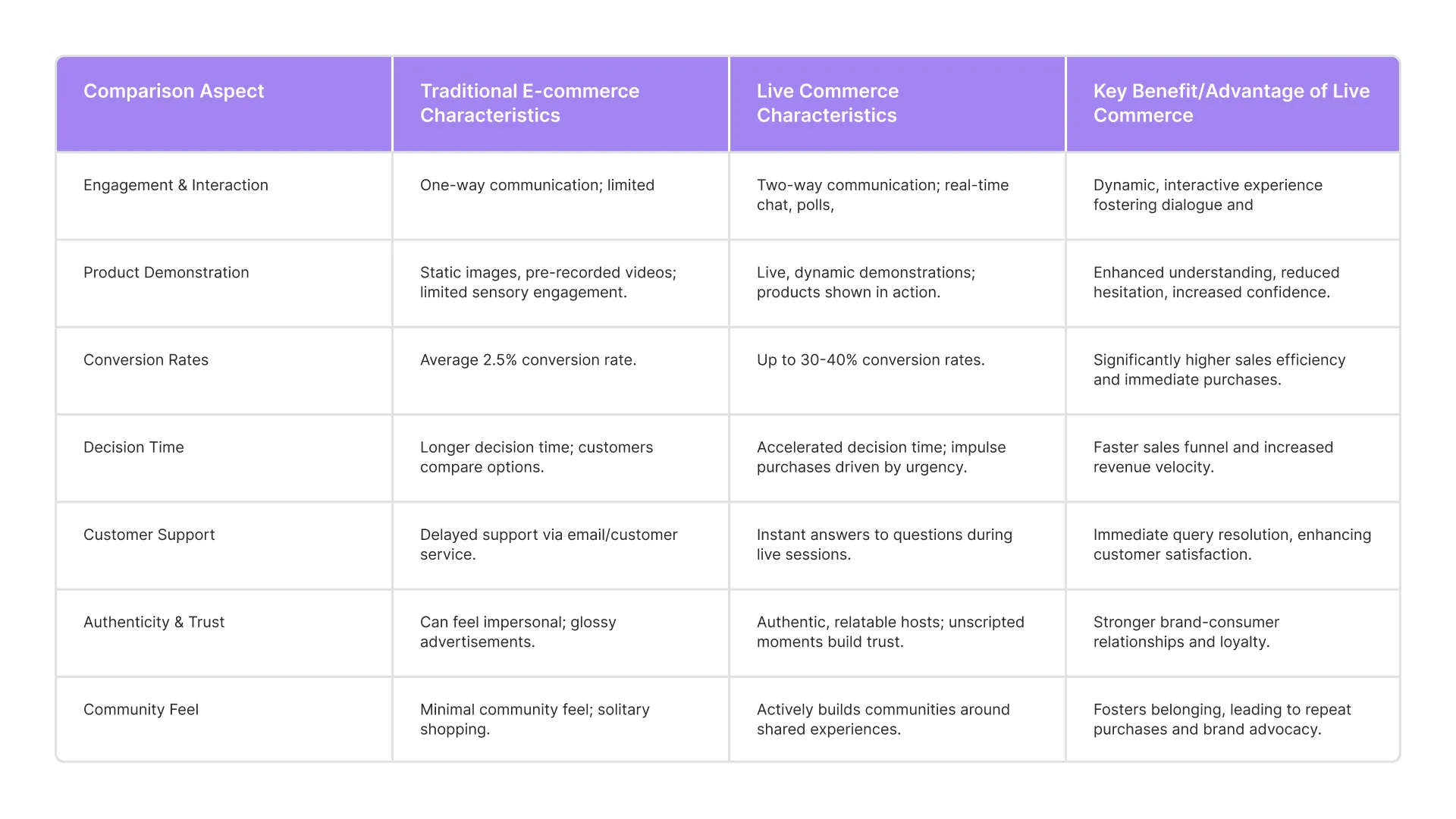Live Commerce | Jordie’s Creative Agency
The Live Commerce Revolution: Transforming Online Shopping Experiences
The digital retail landscape is undergoing a profound transformation, driven by an innovative approach that seamlessly merges real-time video streaming with e-commerce functionality: live commerce. This dynamic phenomenon, also known as live stream shopping or live selling, is rapidly redefining how brands connect with consumers and how products are discovered and purchased online. It represents a significant evolution from traditional static online storefronts, injecting a vibrant, interactive, and human element into the digital marketplace.
What is Live Commerce? A Dynamic Blend of Entertainment and E-commerce
At its core, live commerce is the convergence of live streaming video and e-commerce capabilities, enabling immediate and interactive engagement between sellers and buyers. This innovative format allows for real-time product demonstrations, instant question-and-answer sessions, and seamless purchasing options directly within the live broadcast. Unlike conventional online retail, which often presents a solitary browsing experience, live commerce replicates the dynamic and personal feel of in-store shopping, fostering a more engaging and personal connection between brands and their audiences.
The concept of live selling, while reminiscent of earlier television shopping channels, has experienced an explosive resurgence in the modern digital era. This renewed prominence is profoundly shaped by significant advancements in digital technology. The widespread adoption of social media platforms, the emergence of influential content creators, and sophisticated personalization capabilities are key forces propelling this digital shift. Platforms such as TikTok, Instagram, and Amazon Live are at the forefront of this movement, effectively transforming what was once a passive online shopping experience into a vibrant, two-way conversation between brands and consumers.
The Explosive Growth of Live Stream Shopping: Market Projections for 2025 and Beyond
The global live e-commerce market is currently experiencing a period of robust and sustained expansion, signaling a definitive shift in consumer behavior and retail strategy. Valued at USD 1350 billion in 2024, projections indicate a rise to USD 1502.28 billion in 2025. A parallel analysis of the live commerce platforms market anticipates a surge from $1.26 billion in 2024 to $1.55 billion in 2025, reflecting a Compound Annual Growth Rate (CAGR) of 22.9%. Looking further ahead, the global livestream e-commerce market, estimated at USD 14.93 billion in 2024, is predicted to grow to USD 19.86 billion in 2025, ultimately reaching approximately USD 258.76 billion by 2034, expanding at an impressive CAGR of 33.01% from 2025 to 2034. These compelling figures underscore the undeniable and accelerating momentum towards live selling as a dominant force in online retail.
This significant market escalation is directly attributable to several interconnected factors that create a fertile ground for live commerce to flourish. The ongoing upward trend in general e-commerce adoption provides a broad foundation, while continuous advancements in live streaming technology enable richer, more reliable broadcasts. The burgeoning influence of influencer marketing, coupled with enhanced mobile internet penetration and the pervasive spread of social media platforms, collectively drive this growth. These elements are not merely independent drivers but instead form a synergistic ecosystem. For instance, improvements in live streaming technology directly facilitate the real-time engagement and dynamic product demonstrations that define live commerce. The rise of influencer marketing is exponentially amplified by the proliferation of social media platforms, as these serve as the primary stage for influencer activity and audience reach. Furthermore, enhanced mobile internet adoption and stronger connectivity democratize access to live streams, fostering the increased mobile commerce usage that underpins much of the market’s expansion. This interconnectedness means that each driver strengthens the others, creating a robust and accelerating growth environment. For businesses, this suggests that a successful live commerce strategy requires a holistic digital approach that integrates robust web development to support streaming infrastructure, comprehensive social media marketing for platform leverage and influencer partnerships, and sophisticated content strategy for engaging streams.
Geographically, Asia Pacific currently leads the livestream e-commerce market, holding a substantial 66% share in 2024 and projected to reach around USD 172.08 billion by 2034. However, North America is poised for the fastest growth, projected to expand at the highest CAGR of 30.04% during the forecast period. This rapid growth in North America is driven by the increasing trend of online shopping and a strong foundation provided by established e-commerce companies. The year 2025 is widely recognized as a “tipping point” for live stream shopping. This designation carries a stronger implication than mere market growth; it suggests that the market is reaching a critical mass where adoption shifts from being an advantageous differentiator to a competitive necessity. Businesses that do not embrace live commerce by this point risk not just missing out on growth opportunities but falling significantly behind competitors who are already establishing strong footholds. The competitive landscape is expected to reconfigure rapidly, making it harder and more costly for latecomers to establish market relevance.
To illustrate the scale of this market evolution, consider the following projections:

(Note: Different sources categorize “live commerce” slightly differently, leading to varying market size figures, but all indicate significant growth.)
Unlocking Unprecedented Value: The Benefits of Live Selling for Your Business
The strategic adoption of live selling offers tangible advantages that significantly enhance customer engagement, drive higher conversion rates, and build enduring brand trust, ultimately translating into substantial business growth.
Boosting Customer Engagement and Building Authentic Connections
A cornerstone of live commerce is its capacity to facilitate dynamic, two-way communication. Viewers can directly ask questions about products, receive instant answers from hosts, and engage in conversations, fostering a genuine dialogue. This interactive element creates a human and engaging experience that stands in stark contrast to the often one-way information flow of traditional e-commerce.
Live streams inherently promote authenticity and transparency, a quality particularly appealing to younger generations, such as Gen Z and Millennials, who prioritize genuine interactions over overly polished advertisements. Seeing real people demonstrate products in real-time fosters a sense of trust and relatability that static images cannot achieve. Brands that actively incorporate live interaction into their digital strategies have reported engagement rates increasing by up to 45% across campaigns. Beyond mere transactions, live shopping actively builds communities. It creates a shared, interactive experience where customers can connect with hosts and other viewers, fostering a sense of belonging around a brand or product category. This community aspect contributes significantly to long-term loyalty. The interactivity, authenticity, and direct human connection inherent in live commerce create a deeper emotional bond with the brand. This bond transcends mere transactional convenience; customers feel a personal connection, akin to a relationship. This emotional investment is a powerful driver of customer loyalty, leading to not just repeat purchases but also increased customer lifetime value (CLV) and brand advocacy. Unlike traditional e-commerce where the interaction is largely transactional, live commerce builds a community and a sense of belonging, which are key ingredients for long-term customer retention.
Driving Higher Conversion Rates and Accelerating Sales Opportunities
One of the most compelling benefits of live commerce is its ability to drive significantly higher conversion rates. Live stream events frequently boast conversion rates as high as 30-40%, a dramatic leap compared to the typical 2-3% seen in traditional e-commerce. This efficiency makes live commerce an exceptionally potent sales channel. The real-time nature of live selling, coupled with strategic elements like exclusive “live-only” discounts, flash sales, and countdown timers, effectively creates a natural sense of urgency. This environment is highly conducive to driving impulse purchases, as viewers are incentivized to act quickly to secure deals or products. A common barrier in online shopping is the inability to physically inspect a product. Live commerce directly addresses this by allowing hosts to demonstrate products in action, answer specific questions instantly, and provide detailed insights. This transparency and immediate responsiveness significantly reduce customer hesitation, building confidence and encouraging immediate purchasing decisions.
To further underscore the distinct advantages, a comparison between live commerce and traditional e-commerce highlights the transformative potential:

Cultivating Brand Trust and Loyalty in Real-Time
Live streams provide an unparalleled platform for brands to showcase their true personality, values, and even behind-the-scenes processes in an unscripted, transparent manner. This authenticity is crucial for building deep trust and strengthening the emotional bonds between a brand and its consumers. In the live commerce landscape, influencers have emerged as highly effective hosts. They build significant trust with their followers by offering honest recommendations and creating content that feels natural and relatable. This dynamic makes product advice feel like it’s coming from a trusted friend, rather than a salesperson, significantly boosting credibility and purchasing confidence.
Furthermore, live sessions offer a unique opportunity for brands to gather immediate, unfiltered feedback from their audience. This real-time interaction provides invaluable insights into consumer preferences, concerns, and questions, which can directly inform future product development, marketing strategies, and even customer service improvements. A strategic approach to live commerce involves treating each session as a content engine. Each live event can be repurposed into shorter clips for platforms like TikTok, Instagram Reels, or YouTube Shorts, significantly extending the reach of the session well beyond the initial live event. This approach goes beyond simple content reuse; it highlights a strategic method for maximizing the Return on Investment (ROI) from live commerce efforts. By treating live sessions as a primary content source, brands can generate a wealth of versatile assets (e.g., product demonstrations, frequently asked questions, mini-tutorials, customer testimonials) that can be optimized for various marketing channels. This includes Search Engine Optimization (SEO) through blog posts and YouTube descriptions, targeted Pay-Per-Click (PPC) retargeting campaigns, and integration into email nurturing sequences. This strategic repurposing significantly reduces the ongoing cost and effort of content creation while ensuring consistent brand messaging and extending the reach and impact of a single live event far beyond its initial broadcast.
Navigating the Digital Frontier: Strategic Implementation of Live Commerce
Effectively implementing live commerce requires careful strategic choices and operational considerations to maximize its potential and ensure sustained success.
Choosing the Right Platforms for Interactive E-commerce
The live commerce landscape is rich with diverse platforms, each offering unique strengths and catering to different audience demographics. Key players include social media giants like TikTok Live Shopping, which is particularly effective for targeting Gen-Z with its emphasis on authenticity and its ability to drive impulse purchases. Instagram Shopping is ideal for visual storytelling and direct shopping, while Amazon Live offers immersive brand communication within a vast e-commerce ecosystem. YouTube Live Shopping provides creators a platform for real-time customer engagement, and Facebook Live Shopping enables merchants to host events and showcase products. Beyond these major social media networks, businesses also have the option of utilizing dedicated live commerce platforms or leveraging existing e-commerce platforms that offer integrated shoppable livestream functionalities, such as BigCommerce via the eStreamly app. The choice of platform should always align strategically with the brand’s target audience, product category, and overall brand identity.
Crafting Compelling Content and Engaging Audiences
While production quality is important, the paramount factor in live commerce content is authenticity and relatability. Audiences, particularly younger consumers, value genuine interactions and unscripted moments over overly polished presentations. Brands should focus on developing engaging content that effectively showcases products while maintaining a real, human connection; over-polishing can, in fact, be a significant pitfall. The success of a live stream heavily depends on its host. It is crucial to choose individuals who not only align with the brand’s image but are also skilled in dynamic presentation and audience engagement. Influencers often naturally excel in this role due to their established rapport and trust with their followers. Proper host training in product knowledge, audience interaction, and technical aspects is essential.
To truly differentiate from passive video content, live commerce must be interactive. Incorporating features such as real-time chat, audience polls, direct Q&A sessions, and exclusive “live-only” discounts is vital. Asking direct questions like “Which outfit should I try on next?” makes viewers feel like active participants in the experience. Furthermore, friction in the buying journey can derail even the most engaging live stream. Platforms must refine live shopping tools to enable one-click purchases directly during streams, allowing customers to add items to their carts and complete transactions without leaving the live session. This immediate purchasing capability capitalizes on the urgency and excitement generated by the live event.
Leveraging Data and Analytics for Optimized Performance
Successful live commerce is part of a larger, orchestrated customer journey. This involves strategically guiding customers from initial awareness (through targeted social media ads and informative content) to consideration (via product demos and user-generated content), purchase (through shoppable posts and limited-time deals), and finally, retention (via post-purchase support and loyalty programs). Utilizing social media analytics is crucial for gathering insights from customer interactions and conversations. This data allows brands to decipher purchasing patterns, segment audiences effectively, and create highly targeted advertising campaigns. AI-powered tools can provide real-time views of consumer behavior, competitor activities, and emerging market trends, enabling hyper-personalization and refining product positioning and customer engagement tone.
The personalization in live commerce extends beyond generic product recommendations; it creates a profound sense of recognition and understanding. When a live host directly addresses a viewer’s question, offers a personalized discount based on their real-time interaction, or uses AI to suggest highly relevant products, it builds a stronger psychological connection and fosters immediate trust. This direct, tailored interaction directly addresses customer hesitation and significantly accelerates the decision-making process, leading to the remarkably high conversion rates observed in live commerce. AI is critical for scaling this level of personalization to large audiences, ensuring every viewer feels uniquely catered to.
The work does not end when the live stream concludes. Brands must consistently follow up with viewers, analyze performance metrics (e.g., viewership, engagement rates, conversion rates), and strategically repurpose live session content. This continuous feedback loop is vital for refining future live events, optimizing strategies, and maximizing the overall Return on Investment (ROI).
Jordie’s Creative Agency: Your Partner in Live Commerce Excellence
Empowering Your Brand in the Interactive E-commerce Era
In a rapidly evolving digital landscape where live commerce is poised to become a critical “tipping point”, securing an expert partner is not merely advantageous—it is essential for long-term success. Jordie’s Creative Agency possesses a profound understanding of the intricate dynamics of this burgeoning market, encompassing everything from robust technological infrastructure to compelling content creation and sophisticated audience engagement strategies.
At Jordie’s Creative Agency, it is understood that successful live selling is never a standalone tactic. Instead, it must be seamlessly integrated as a vital component of a comprehensive and robust digital strategy. Our expertise ensures that live commerce initiatives are not only impactful on their own but also synergistically woven into a broader marketing and sales ecosystem, thereby maximizing overall impact, reach, and Return on Investment (ROI).
Our Comprehensive Services for Live Commerce Success:
Jordie’s Creative Agency offers a full suite of services designed to empower brands in the interactive e-commerce era:
- UI/UX Design: Crafting Intuitive Live Shopping Journeys.
- Brand Positioning & Logo Design: Establishing Your Live Commerce Identity.
- Content Marketing: Fueling Your Live Stream Strategy.
- Search Engine Optimization (SEO): Maximizing Live Commerce Visibility.
- Pay-Per-Click (PPC) Services: Driving Targeted Live Stream Traffic
- Social Media Marketing: Amplifying Your Live Selling Reach.
- Video Marketing: The Core of Engaging Live Commerce.
The true power of a comprehensive service offering, when applied to live commerce, lies in its synergistic effect. Success in live selling is not achieved by merely having a live stream; it depends on a robust, integrated digital ecosystem. For example, a highly engaging live stream (Video Marketing, Content Marketing) will only translate into high conversions if the underlying website infrastructure is stable (Website Design & Development), the user interface is intuitive (UI/UX Design), the brand message is consistent (Brand Positioning), and the event is effectively promoted and discovered (SEO, PPC, Social Media Marketing). A weakness in one area, such as a clunky checkout process leading to cart abandonment, can undermine the effectiveness of all other efforts. The ability to provide these services under one roof ensures seamless integration and a cohesive strategy, elevating the value proposition from a collection of services to that of a holistic strategic partner.
The Future of Shopping: AI, AR, and VR in Live Commerce
The future of live commerce is poised for revolutionary advancements, driven by cutting-edge technologies that promise unprecedented personalization and immersive shopping experiences.
Personalization Redefined: The Role of AI in Real-Time Online Shopping
Artificial Intelligence (AI) is rapidly transforming live commerce by enabling hyper-personalized shopping experiences. AI-powered tools can analyze vast amounts of data, including viewers’ preferences, browsing behavior, and purchase history, to deliver highly tailored product recommendations during live streams. This goes beyond basic suggestions, with AI even interpreting subtle styling cues during Augmented Reality (AR) try-ons to provide truly bespoke assistance. Looking ahead, AI will evolve beyond mere recommendation engines to become intelligent shopping assistants. These advanced AI agents will guide customers through virtual tours, answer complex product queries in natural language, and even facilitate purchases through intuitive conversational interfaces. This shift moves the focus from traditional search and filter mechanisms to a more dynamic, dialogue-driven shopping experience. The influence of AI extends beyond the customer-facing experience. AI can significantly optimize critical backend operations for live commerce, including supply chain logistics, inventory management, dynamic pricing strategies, and customer relationship management. These efficiencies contribute to improved profitability and enhanced scalability for live selling operations.
Immersive Experiences: Augmented and Virtual Reality in Live Selling
Augmented Reality (AR) is revolutionizing the online shopping experience by allowing customers to visualize products within their own real-world environments. This capability is particularly impactful for live selling, enabling interactive and immersive experiences such as virtual try-ons for fashion, beauty products, and even furniture. By reducing the uncertainty associated with online purchases, AR significantly boosts buyer confidence and helps to reduce product return rates. The future of AR shopping experiences promises significantly improved visual fidelity. Next-generation depth sensing technology, combined with advanced lighting algorithms, will enable virtual products to be placed more accurately and respond naturally to ambient lighting conditions within real environments. Furthermore, AR experiences are set to integrate directly with payment systems, allowing for seamless, one-click purchases without ever leaving the immersive AR environment.
Virtual Reality (VR) offers the potential for truly immersive shopping environments. Brands can create virtual showrooms where customers can explore 3D products, interact with friends, and even receive support from virtual staff, effectively replicating and enhancing the physical store experience. This is particularly valuable for high-investment products or complex items where a deep, interactive exploration is beneficial. Traditional e-commerce inherently suffers from “limited sensory engagement” and often leads to “higher return rates” because customers cannot physically interact with products. AI’s advanced personalization directly addresses decision fatigue by presenting highly relevant options, shortening the sales cycle. Crucially, AR’s “virtual try-on” capabilities and VR’s “virtual showrooms” directly overcome the sensory limitation, allowing customers to “virtually try products before purchase”. This direct mitigation of key friction points (uncertainty, lack of physical interaction) translates directly into increased buyer confidence, accelerated purchase decisions, and significantly higher conversion rates, while simultaneously reducing costly returns. The integration of these advanced technologies is not just about novelty or “cool features” but about fundamentally solving long-standing e-commerce challenges.
This future also implies a profound paradigm shift in how consumers interact with online retail. Instead of actively navigating and filtering, the shopping experience becomes more akin to having a personalized consultation with a knowledgeable salesperson, driven by AI. This “vibe shopping” prioritizes intuitive, natural language interaction and predictive assistance, potentially lowering the barrier to entry for less tech-savvy users and significantly enhancing satisfaction for all. It also points towards the increasing importance of voice commerce and seamless, end-to-end conversational pathways for purchase.
Overcoming Challenges and Capitalizing on Opportunities
While the potential of live commerce is immense, its implementation comes with practical hurdles and limitations that require strategic foresight and expert partnership.
Addressing Scalability, Logistics, and Technical Hurdles
Despite its highly engaging nature, live commerce can face challenges related to scalability. The capacity of a host to manage a large number of viewers and their real-time interactions can be limited. Scaling effectively may necessitate multiple hosts and a larger technical support staff. Furthermore, inadequate underlying infrastructure can lead to disruptions during high-traffic live events. Managing inventory and efficiently processing a high volume of orders generated during live events can present significant logistical hurdles. These can potentially lead to delivery delays, stock-outs, and difficulties in consistently maintaining product quality and ensuring high customer satisfaction, especially as sales accelerate. The success of a live stream is heavily reliant on robust and reliable streaming technology that delivers high-quality video and audio. Any technical glitches, buffering issues, or connectivity problems during a live broadcast can severely disrupt the experience and lead to frustrated customers. Consistent and high-speed internet connectivity is a foundational requirement. As the live commerce market expands and more customer data is collected and processed in real-time, safeguarding sensitive customer information and ensuring secure payment transactions become paramount. Concerns about data breaches and privacy must be meticulously addressed to maintain consumer trust.
Strategies for Sustained Growth and Customer Retention
To ensure sustained growth and prevent hitting a ceiling, brands must make early investments in modular tech stacks, scalable cloud infrastructure, and efficient fulfillment partners. This foresight allows businesses to handle increased traffic and sales volumes seamlessly, avoiding the pitfalls of outdated systems. In a rapidly expanding market like live commerce, the ability to scale operations quickly, reliably, and efficiently becomes a significant competitive differentiator. Brands that proactively invest in robust, flexible infrastructure are better positioned to seize emerging market share, handle unpredictable spikes in demand (common during successful live events), and seamlessly integrate future technological advancements like AI/AR/VR. Conversely, those that delay or underinvest will face “limited scalability options”, struggle with poor customer experiences (e.g., slow loading times, disrupted streams), and ultimately lose customers to more agile competitors. This investment transforms from a mere operational cost into a strategic enabler for market leadership.
The challenge of delivering truly tailored experiences at scale can be addressed by leveraging AI-powered personalization engines. These systems can interpret purchase intent, browsing context, and even predictive needs, ensuring that personalized recommendations and interactions remain effective even with a large audience. High cart abandonment rates remain a persistent issue in e-commerce. Live commerce can directly mitigate this by offering real-time support and addressing hesitations instantly. Strategies include streamlining checkout processes, offering a variety of preferred payment options, providing clear shipping costs upfront, and integrating live chat tools and sales chatbots to assist customers during their purchasing journey. The direct interaction, real-time product demonstrations, and immediate Q&A sessions directly address these traditional pain points. For example, a customer asking “Does this work for sensitive skin?” and receiving an instant, authentic answer removes hesitation, which is a major contributor to cart abandonment. The human element and the presence of trusted influencers build a level of confidence and trust that static images and text cannot, thereby reducing returns and significantly boosting conversion rates. Thus, the very human nature of live commerce serves as a powerful solution to the inherent limitations of a purely digital, non-interactive shopping experience.
Acquiring new customers is significantly more costly than retaining existing ones. Therefore, prioritizing customer retention through effective loyalty programs, personalized post-purchase communications, and exceptional customer service (including the use of AI chatbots for quick query resolutions) is crucial for long-term profitability. Live commerce excels at building the community and emotional connection that are fundamental to robust retention strategies.
Inspiring Success: Real-World Live Commerce Case Studies
Concrete examples of brands that have successfully implemented live commerce lend credibility to its potential and offer practical insights for aspiring businesses.
Brands Thriving in the Live Stream Arena
The retail giant Walmart has aggressively pioneered shoppable livestreams across multiple platforms, including TikTok, YouTube, and its proprietary app. Their strategy involves focusing on niche audiences and strategically partnering with trusted influencers and even legendary celebrity talent, such as Dolly Parton, to drive highly targeted engagement and significant conversions. This demonstrates the broad applicability and power of live commerce even for established brands. Amazon, a titan in the e-commerce world, has seamlessly integrated live shopping into its expansive ecosystem, particularly around major shopping events like Prime Day, leveraging its vast customer base and sophisticated existing e-commerce infrastructure to create compelling live selling experiences.
The global beauty powerhouse L’Oréal achieved remarkable success, surpassing $1 million in sales on TikTok Shop’s Super Brand Day in the UK. This impressive feat highlights the significant direct sales performance achievable through live commerce and underscores L’Oréal’s global rollout of live shopping experiences. As an early adopter of live commerce in Western markets, the German beauty retailer Douglas has reported exceptionally high conversion rates, reaching up to 40% for its livestream shows. This specific example powerfully illustrates the high conversion potential that live selling offers. A single live show hosted by Tommy Hilfiger in China garnered an astounding 14 million viewers and resulted in the sale of 1,300 hoodies in just two minutes. This case study vividly demonstrates the immense reach and rapid sales acceleration capabilities inherent in live commerce. The dedicated live shopping app Whatnot has achieved a staggering $5 billion valuation. This success story underscores the significant investment and robust market potential present in specialized live commerce platforms, indicating a growing ecosystem beyond traditional social media.
The sheer diversity of successful brands—from retail giants like Walmart to beauty powerhouses like L’Oréal and specialized platforms like Whatnot—succeeding on various platforms (TikTok, Amazon Live, dedicated apps) strongly indicates that there is no universal “right” way to implement live commerce. Instead, success is contingent upon meticulously tailoring strategies to align with specific brand identities, target audience demographics, product categories, and the unique strengths of chosen platforms. This adaptability is a key characteristic of the live commerce phenomenon, suggesting that a one-size-fits-all approach is ineffective. The role of influencers in live commerce has evolved significantly beyond simple product endorsements. They are becoming integral “hosts,” “partners,” and even “producers” of live shopping events. This means brands need to develop sophisticated influencer marketing strategies that focus on building authentic, long-term relationships and fostering true co-creation of content, rather than just transactional campaigns. The success of Walmart’s collaboration with Dolly Parton further illustrates that this partnership model extends to celebrity endorsements, but the underlying principle remains the human connection and the trust the audience places in the personality. This shift requires brands to cede a degree of control and embrace a more collaborative content creation model.
Conclusion: Embrace the Future of Retail with Jordie’s Creative Agency
Live commerce is far more than a fleeting trend; it represents a fundamental and transformative shift in the landscape of online retail. It offers unparalleled opportunities for brands to foster deep customer engagement, achieve dramatically higher conversion rates, and cultivate enduring brand trust. Its explosive growth, driven by relentless technological advancements and rapidly evolving consumer preferences, firmly establishes it as an indispensable strategy for any business aiming for sustained success in the digital future.
The year 2025 stands as a critical “tipping point” for live stream shopping. Brands that proactively embrace this dynamic and interactive strategy now are uniquely positioned to lead the charge into the future of digital shopping, capturing significant market share and establishing themselves as innovators. Conversely, delaying adoption risks falling irrevocably behind competitors who are already harnessing its immense power and building loyal communities.
Jordie’s Creative Agency offers holistic and integrated expertise across all critical facets of digital success: from robust website design and development and intuitive UI/UX design to strategic brand positioning, compelling content marketing, powerful SEO and PPC campaigns, impactful social media marketing, and cutting-edge video marketing. This comprehensive approach positions the agency as the ideal, indispensable partner to expertly navigate the complexities of live commerce, effectively overcome its inherent challenges, and build a sustainable, highly profitable live selling strategy tailored precisely to a brand’s unique needs. The future of retail is interactive, authentic, and live. Contact us today!






